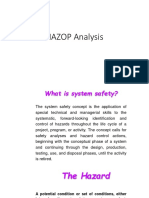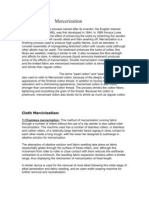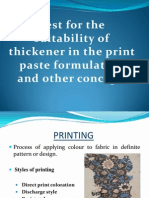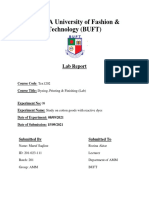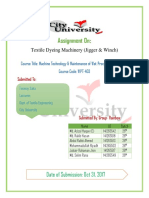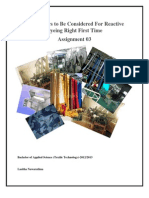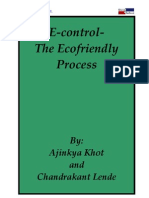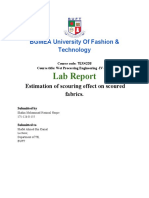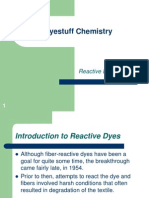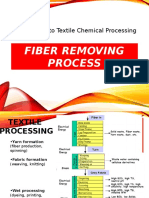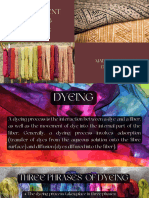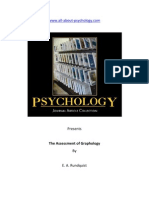Disperse Dye
Disperse Dye
Uploaded by
MD saifu lislamCopyright:
Available Formats
Disperse Dye
Disperse Dye
Uploaded by
MD saifu lislamOriginal Title
Copyright
Available Formats
Share this document
Did you find this document useful?
Is this content inappropriate?
Copyright:
Available Formats
Disperse Dye
Disperse Dye
Uploaded by
MD saifu lislamCopyright:
Available Formats
Disperse Dye
Disperse dyes:
The term “disperse dye” have been applied to the organic colouring substances which are free from
ionizing groups, are of low water solubility and are suitable for dyeing hydrophobic fibres. The dye
has derived its name for its insoluble aqueous properties and the need to apply it from an aqueous
dispersion. Of all the dyes, they are of the smallest molecular size. Disperse dyes have substantivity
for one or more hydrophobic fibres e.g. cellulose acetate, nylon, polyester, acrylic and other
synthetic fibres.
Properties of Disperse Dyes:
Disperse dyes are nonionic dyes. So, they are free from ionizing group.
They are ready made dyes and are insoluble in water or have very low water solubility.
They are organic coloring substances which are suitable for dyeing hydrophobic fibres.
Disperse dyes are used for dyeing man made cellulose ester and synthetic fibres specially
acetate and polyester fibres and sometimes nylon and acrylic fibres.
Disperse dyes have fair to good light fastness with rating about 4-5.
The wash fastness of these dyes is moderate to good with rating about 3-4.
Of all dyestuffs disperse dyes are of smallest molecular size.
Generally disperse dyes are derivatives of azo, anthroquinone, nitro and quinine groups.
Dyeing Mechanism of Disperse Dye:
The dyeing of hydrophobic fibres like polyester fibres with disperse dyes may be considered as a
process of dye transfer from liquid solvent (water) to a solid organic solvent (fibre). Disperse dyes
are added to water with a surface active agent to form an aqueous dispersion. The application of
heat to the dye liquor increases the energy of dye molecules and accelerates the dyeing of textile
fibres. Heating of dye liquor swells the fibre to some extent and assists the dye to penetrate the fibre
polymer system. Once taking place within the fibre polymer system, the dye molecules become
attached by hydrogen bonds and Van Der Waals’ force.
Classification of Disperse Dyes:
According to Fastness Property:
Group A: These dyes have excellent dyeing properties and good fastness properties.
Group B: These dyes are excellent in high temperature and for carrier dyeing with moderate
fastness.
Group C: These dyes are moderate for carrier and high temperature dyeing with higher fastness
property than group B dyes.
Group D: These dyes are of excellent fastness to heat but for dyeing properties on carrier method.
According to Energy Requirement:
Low energy dyes: These dyes are used to dye with carrier. For dyeing 77°C temperature is required.
They have extremely poor resistance to sublimation.
Medium energy dyes: These dyes are used to dye mostly in between temperature 104°C-110°C
which provides better sublimation fastness than that of low energy dyes.
High energy dyes: These dyes are used to dye at temperature above 129°C and are suitable for
continuous dyeing. They provide all round fastness properties.
Prepared by Sumon Mozumder,
M.Engg. (BUET), M.Sc.Engg. (Textile), B.Sc.Tech (BUTex)
Assistant Professor, Department of Textile Engineering
Application Methods of Disperse Dyes:
Method N: Normal dyeing method. Dyeing temperature is between 80-100°C.
Normal NC method: Method of dyeing at normal temperature with carriers. Dyeing
temperature is between 80-100°C.
Method HT: High temperature dyeing method. Dyeing temperature is between 105-140°C.
Method T: Thermasol dyeing method. Dyeing temperature is between 180-220°C, continuous
method of dyeing.
Pad roll method: Semi continuous dyeing method.
Pad steam method: Continuous dyeing method.
Factors Considered for Selection of a Method:
1. Availability of dyeing machine.
2. Required colour effect (dark/medium/light).
3. Required colour fastness.
4. Type of material to be dyed.
5. Cost of dye, chemicals and auxiliaries.
6. Overall economy of the system.
7. Dyeing temperature.
Dispersing Agent:
Disperse dyes are insoluble in water and form aqueous dispersion in water. Since they are water
insoluble, they will give uneven dyeing if they are directly used in dye bath. So, to ensure uniform
and trouble free dyeing the dye should be present in dye bath in a uniform and very fine form and
should give a stable dispersion. This is the reason for which a special chemical is used in dye bath
named dispersing agent. They should be effective under dyeing conditions, stable to hard water,
high temperature and other dyeing assistants. For example, alkali sulphates, alkyl aryl sulphonates
etc. are some surface active agents which are recommended as dispersing agents in disperse dyeing.
Reduction Cleaning:
In case of dark shade dyeing, we have to use more amounts of dye and chemicals. But, these
chemicals should be removed from fabric after dyeing. For this reason, a special process is used in
case of disperse dyeing. This cleaning process is called reduction cleaning. By reduction cleaning,
surface dye molecules or unfixed dye molecules are stripped and this in turn results in level dyeing.
Reduction cleaning also improves wash fastness property of textile material.
Carriers:
It has been established that certain hydrocarbons, phenols, amino acids, amides, alcohols, esters,
ketones, nitriles etc. accelerate the rate of dyeing polyester fibre with disperse dyes from aqueous
medium at temperature up to 100°C. These dyeing assistants alter the dispersing properties of the
dyes and the physical characteristics of the fibre so that more dye can be transferred from the dye
bath to the fibre. These are called carriers and are necessary for dyeing polyester fibres at the
normal pressure and temperature below 100°C to increase the dyeing rate and to permit dye
migration within the fibre.
Dyeing of polyester fabric with disperse dye in carrier method:
The extreme crystalline nature of polyester fibres creates problems in obtaining dark shades by
conventional dyeing methods even at high temperature. The carriers are found to assist the disperse
Prepared by Sumon Mozumder,
M.Engg. (BUET), M.Sc.Engg. (Textile), B.Sc.Tech (BUTex)
Assistant Professor, Department of Textile Engineering
dyes to enter the polyester polymer, enabling dark shades to be produced. The carriers swell the
polyester fibres, increase inter polymer space and let the dye molecules to enter the polymer system
easily.
Advantages of Carrier Dyeing:
1) In conventional dyeing method, the extremely crystalline polyester fibres cannot be dyed in
deep shade. But, by using carrier we can get medium to dark shade in boiling temperature.
2) Materials can be dyed with simple equipments at atmospheric pressure and temperature
below 100°C.
3) Rate of dyeing can be increased by using carriers.
4) Can be dyed quickly by using carriers.
5) Improves fastness properties of fabric except light fastness.
Disadvantages of Carrier Dyeing:
1) Carriers add to production cost of dyeing. Firstly, for dyeing it is used which is costly and
secondly for its removal alkali is required.
2) Carriers are unhygienic and toxic. It creates skin diseases.
3) Some dyeing machines may create carrier spot.
4) Carriers affect the light fastness property of dyed material. This effect may be reduced by
treating the material with hot air for 30 min.
Dyeing of Polyester Fabric in High Temp Dyeing Method:
In high temperature dyeing method either material or liquor should be circulated. Otherwise dye
molecules will not penetrate inside the material. They will stay on surface only. In this method,
temperature is kept in between 105-140°C and pressure is kept from 0 to 170 kPa. This method is
also known as pressure dyeing which is used for highly crystalline synthetic fibres and their blends.
This technique causes the fibre to swell even more than which achieved at 100°C temperature so
that dye molecules penetrate the fibre polymer system. It eliminates the need of carriers.
Dyeing of Polyester Fabric in Thermasol Dyeing Method:
Thermasol method is a continuous method of dyeing with disperses dye. Here dyeing is performed
at high temperature like 180-220°C in a closed vessel. Here, time of dyeing should be maintained
very carefully to get required shade and to retain required fabric strength.
Advantages of thermosol dyeing:
1. This process is useful for dyeing thermoplastic fibres like polyesters, nylon, acrylic etc.
2. It is a continuous dyeing process with high production rate.
3. The process is non-toxic and no carrier is used.
4. Less shrinkage occurs.
5. No additional problem of remaining carrier with alkali.
6. Excellent dye utilization (75-90%) is achieved.
7. Large yardages can be dyed economically.
Disadvantages:
1. Shade may be changed by sublimation.
2. Special closed vessel m/c is required.
3. Loss of strength of fabric occurs if temperature and time is not maintained carefully.
4. M/c cost is high so initial capital should be high.
5. Small amount of fabrics cannot be dyed. At least, 1000 yards of fabrics is required for
dyeing.
Prepared by Sumon Mozumder,
M.Engg. (BUET), M.Sc.Engg. (Textile), B.Sc.Tech (BUTex)
Assistant Professor, Department of Textile Engineering
You might also like
- 4 - Reactive DyeingDocument39 pages4 - Reactive Dyeingfayera letaNo ratings yet
- Dyehouse Doctor Laboratory ManualDocument22 pagesDyehouse Doctor Laboratory ManualMaja Goldfish100% (2)
- Project Report On KFC BhoomikaDocument57 pagesProject Report On KFC BhoomikaLakshyaSehgal100% (3)
- HAZOP AnalysisDocument35 pagesHAZOP AnalysisGopi Krish100% (3)
- Energy QuestionsDocument2 pagesEnergy QuestionsAbdisalaam mohamudNo ratings yet
- Introduction of Dyeing PDFDocument13 pagesIntroduction of Dyeing PDFImran100% (1)
- Disperse DyeDocument44 pagesDisperse DyeRatul Hasan100% (1)
- Chemical Testing DyeingDocument23 pagesChemical Testing DyeingMah Gul100% (1)
- National Textile University Faculty of Engineering & TechnologyDocument11 pagesNational Textile University Faculty of Engineering & TechnologyShahan Akhtar100% (1)
- Disperse DyesDocument23 pagesDisperse DyesPratik Minj100% (3)
- 3) Theory of DyeingDocument12 pages3) Theory of DyeingSanaullah Murad100% (1)
- Solvent DyeingDocument11 pagesSolvent DyeingMd Makhdum Amin Fahim100% (1)
- Textile Dyeing LectureDocument28 pagesTextile Dyeing LectureMuhammad Zohaib100% (1)
- Basics of DyeingDocument18 pagesBasics of DyeingProfessorTextechNo ratings yet
- MercerizationDocument7 pagesMercerizationRahadian Noor MadanyNo ratings yet
- Fastness Test Textile Testing-Ii: Farhana Momotaz Assistant Professor Dept. of Textile Engineering, KUETDocument28 pagesFastness Test Textile Testing-Ii: Farhana Momotaz Assistant Professor Dept. of Textile Engineering, KUETmehedi ruhitNo ratings yet
- Dyeing Nylon With Acid Dyes PDFDocument9 pagesDyeing Nylon With Acid Dyes PDFirc.indusNo ratings yet
- Study On Different Types of Dyeing Faults PDFDocument10 pagesStudy On Different Types of Dyeing Faults PDF呂仲書100% (1)
- Bleachnig TextilesDocument7 pagesBleachnig TextilesrahilwalaniNo ratings yet
- Dyeing-Pad Batch AssignmentDocument22 pagesDyeing-Pad Batch AssignmentTooba Anum100% (1)
- 191003060-Lab Report 5Document6 pages191003060-Lab Report 5Tanzila NusratNo ratings yet
- MercerizationDocument3 pagesMercerizationsyed asim najam100% (1)
- Methods of ColorationDocument11 pagesMethods of ColorationFerdous Khan RubelNo ratings yet
- Wet Processing Engineering - WikipediaDocument51 pagesWet Processing Engineering - WikipediaFahad AliNo ratings yet
- BiopolishingDocument8 pagesBiopolishingSivakumar KNo ratings yet
- Test For The Suitability of Thickener in The Print Paste Formulation and Other ConcepttestDocument21 pagesTest For The Suitability of Thickener in The Print Paste Formulation and Other ConcepttestGaurav Dhawan100% (1)
- DPF Lab Report (8-13)Document25 pagesDPF Lab Report (8-13)Jisun AhmedNo ratings yet
- Dyeing Process of Cotton Fabric With Reactive DyesDocument6 pagesDyeing Process of Cotton Fabric With Reactive DyesShaheen Monir HossainNo ratings yet
- Contineous Dyeing of Reactive DyesDocument9 pagesContineous Dyeing of Reactive DyesMohammed Atiqul Hoque ChowdhuryNo ratings yet
- Introduction To Dyeing and Finishing Technology On Polyester Fibre and Its BlendsDocument58 pagesIntroduction To Dyeing and Finishing Technology On Polyester Fibre and Its BlendswsarakarnNo ratings yet
- Acid DyeDocument3 pagesAcid DyeMD. Tofazzal HossainNo ratings yet
- Jigger and Winch Dyeing MachineDocument10 pagesJigger and Winch Dyeing MachineSajid arNo ratings yet
- Types of Dyeing ProcessesDocument5 pagesTypes of Dyeing ProcessesSyed Inamullah ShahNo ratings yet
- Printing Techniques and Printing Defects11Document15 pagesPrinting Techniques and Printing Defects11Supriya Bagh100% (1)
- Singeing Process: Presented By: Bhawana Mohta Manuj Shukla Nuti Mehta Dhruva Vaghela Presented To: Prof Pranav VoraDocument19 pagesSingeing Process: Presented By: Bhawana Mohta Manuj Shukla Nuti Mehta Dhruva Vaghela Presented To: Prof Pranav VoraManuj ShuklaNo ratings yet
- Acid DyeDocument35 pagesAcid DyeHina ArifNo ratings yet
- Scouring and Bleaching - PresentationDocument14 pagesScouring and Bleaching - PresentationTanvir Ahmed100% (2)
- Cold Pad BatchDocument5 pagesCold Pad BatchCarlos Ernesto Aguilar López100% (2)
- Key Factors To Be Considered For Reactive Dyeing Right First TimeDocument12 pagesKey Factors To Be Considered For Reactive Dyeing Right First TimeLasitha Nawarathna50% (2)
- Reactive Printing PDFDocument9 pagesReactive Printing PDFshivanshNo ratings yet
- Dyeing Theory PDFDocument50 pagesDyeing Theory PDFRamnath Kumar Yadav100% (2)
- Wool and Silk PretreatmentDocument26 pagesWool and Silk PretreatmentKassahun TadeleNo ratings yet
- Color FastnessDocument68 pagesColor FastnessSaurabh Singh Rajput100% (5)
- E CONTROlDocument5 pagesE CONTROlHrishikesh Dhawadshikar100% (2)
- Disperse Dyes For Printing On PolyesterDocument2 pagesDisperse Dyes For Printing On PolyesterFathi Mustafa100% (1)
- Estimation of Scouring Effect On Scoured Fabrics.Document3 pagesEstimation of Scouring Effect On Scoured Fabrics.nasimul haqueNo ratings yet
- Jigger Dyeing Machine:: Fabric PreparationDocument2 pagesJigger Dyeing Machine:: Fabric PreparationnaaomaiNo ratings yet
- Dyeing of Polyester and CottonDocument3 pagesDyeing of Polyester and CottonSivakumar K0% (1)
- Calculation of Dyestuffs and Auxiliaries For Effective Wet Processing TechnologyDocument3 pagesCalculation of Dyestuffs and Auxiliaries For Effective Wet Processing TechnologyAlexander DeckerNo ratings yet
- Basic DyeDocument14 pagesBasic DyePrita SinghNo ratings yet
- DesizingDocument40 pagesDesizingaqsa imranNo ratings yet
- Mercer IzationDocument75 pagesMercer IzationTanmay JagetiaNo ratings yet
- Reactive DyesDocument45 pagesReactive DyesRavi AdityaNo ratings yet
- Textile PretreatmentDocument23 pagesTextile PretreatmentAyman BrohiNo ratings yet
- Lecture 1 & 2 Singeing&ShearingDocument31 pagesLecture 1 & 2 Singeing&Shearingrehanabbaci100% (1)
- Seer SuckeringDocument24 pagesSeer SuckeringAbdul kader100% (1)
- Dyeing of Polyester Fabric With Disperse DyesDocument4 pagesDyeing of Polyester Fabric With Disperse DyesKushagradhi Debnath75% (4)
- Presentation - WPT CLT IVDocument39 pagesPresentation - WPT CLT IVSaidul KarimNo ratings yet
- Dyeing of Polyester With Disperse DyesDocument21 pagesDyeing of Polyester With Disperse Dyesirfanfakhar2100% (1)
- Fabric Science Final AssignmentDocument14 pagesFabric Science Final AssignmentNayanika DayalNo ratings yet
- Polyester DyeingDocument5 pagesPolyester Dyeingimran1200No ratings yet
- Colour Theory, Dyes & PigmentsDocument33 pagesColour Theory, Dyes & PigmentsAbhinav Verma100% (3)
- Process of Dyeing On Cotton FabricsDocument8 pagesProcess of Dyeing On Cotton FabricsMUhammad AsifNo ratings yet
- Electrostatic InductionDocument1 pageElectrostatic InductionArpit AgrawalNo ratings yet
- Edifier x6Document38 pagesEdifier x6Fábio MenezesNo ratings yet
- Harga SKINTIFIC DISCUSDocument1 pageHarga SKINTIFIC DISCUSduadara medikaNo ratings yet
- European Biotechnology Guide 2020 ISSUUDocument196 pagesEuropean Biotechnology Guide 2020 ISSUUj6gNo ratings yet
- E21-G02 - 1 Identification of Circuit Conductor & Phase RelationDocument6 pagesE21-G02 - 1 Identification of Circuit Conductor & Phase RelationMuhammad IrfanNo ratings yet
- Speaking Practice For Module 14Document3 pagesSpeaking Practice For Module 14paladiusNo ratings yet
- QuestionnaireDocument15 pagesQuestionnaireSwati PanditNo ratings yet
- PIX Control WiringBOMDocument8 pagesPIX Control WiringBOMElectrical DistributionNo ratings yet
- Sim v. NLRC DigestDocument2 pagesSim v. NLRC DigestJoyce Baylon100% (2)
- Technical Offer: OrascomDocument28 pagesTechnical Offer: OrascomAhmed HussienNo ratings yet
- FORKY's Healthcare Information From VCA Simmons Animal HospitalDocument3 pagesFORKY's Healthcare Information From VCA Simmons Animal HospitalcynthiaxgallNo ratings yet
- Po1 Po2 Po3 Po4 Po5 Po6 Po7 Po8 Po9 Po10 Po11 Po12 Po13 Po14Document16 pagesPo1 Po2 Po3 Po4 Po5 Po6 Po7 Po8 Po9 Po10 Po11 Po12 Po13 Po14Jerry AbleNo ratings yet
- Mortein What Lies Beneath Brand PositionDocument17 pagesMortein What Lies Beneath Brand PositionChamod PrabashwaraNo ratings yet
- Catalogo Schneider ElectricDocument72 pagesCatalogo Schneider Electricciro_peralocaNo ratings yet
- Conseal 250Document2 pagesConseal 250Rabih GergesNo ratings yet
- Cutting ToolsDocument26 pagesCutting ToolsGapuz EdwinNo ratings yet
- Acuitus Manual in Word 2001 - origEN - Doc - BA-AcuitusMulti-LanguageManual PDFDocument7 pagesAcuitus Manual in Word 2001 - origEN - Doc - BA-AcuitusMulti-LanguageManual PDFRene CabreraNo ratings yet
- Overview of Healthcare in The UKDocument7 pagesOverview of Healthcare in The UKLu DhonnaNo ratings yet
- Handwriting AnalysisDocument8 pagesHandwriting AnalysisDavidNo ratings yet
- Ergonomic & Safety Assessment Guide For Machines and EquipmentDocument8 pagesErgonomic & Safety Assessment Guide For Machines and EquipmentqwertyNo ratings yet
- Intermediate CoursesDocument5 pagesIntermediate Coursesghousiya063No ratings yet
- DR RMLAU Approved M.sc. MLT Syllabus 2020-2021Document47 pagesDR RMLAU Approved M.sc. MLT Syllabus 2020-2021mrhlabiocl2023No ratings yet
- Megaplex-4 System MN 4.91Document1,181 pagesMegaplex-4 System MN 4.91jerryhamstersgNo ratings yet
- Histrionic Personality DisorderDocument2 pagesHistrionic Personality DisorderMarietta JuaniteNo ratings yet
- Chapter 15Document12 pagesChapter 15Cymon JimenezNo ratings yet
- Carrier Evaluation FormDocument1 pageCarrier Evaluation FormdnmuleNo ratings yet
- C25 33 Generating SetDocument2 pagesC25 33 Generating SetНиколай ТаранNo ratings yet



